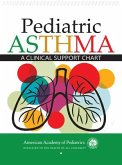Debra L Palazzi, John S. Bradley, John D. Nelson, John C. Arnold, Barnett Elizabeth
2025 Nelson's Pediatric Antimicrobial Therapy
Herausgeber: Palazzi, Debra L; Nelson, John D; Bradley, John S
Debra L Palazzi, John S. Bradley, John D. Nelson, John C. Arnold, Barnett Elizabeth
2025 Nelson's Pediatric Antimicrobial Therapy
Herausgeber: Palazzi, Debra L; Nelson, John D; Bradley, John S
- Broschiertes Buch
- Merkliste
- Auf die Merkliste
- Bewerten Bewerten
- Teilen
- Produkt teilen
- Produkterinnerung
- Produkterinnerung
Completely updated and revised, the 31st edition of this best-selling reference provides instant access to the latest recommendations for treatment of infectious diseases in children. For each disease, the authors provide a commentary to help select the best of all antimicrobial choices. Drug descriptions cover all antimicrobial agents available today and include complete information about dosing regimens. New in the 31st Edition New guidelines for: * Acute Bacterial Arthritis * Mpox (monkeypox) * Respiratory syncytial virus (RSV) prophylaxis * Topical antimicrobials * Congenital Cytomegalovirus * Clostridioides therapy * Pelvic inflammatory disease…mehr
Andere Kunden interessierten sich auch für
![Quick Reference Guide to Pediatric Care Quick Reference Guide to Pediatric Care]() Deepak M. KamatQuick Reference Guide to Pediatric Care112,99 €
Deepak M. KamatQuick Reference Guide to Pediatric Care112,99 €![Pediatric Asthma: A Clinical Support Chart Pediatric Asthma: A Clinical Support Chart]() American Academy of Pediatrics (Aap)Pediatric Asthma: A Clinical Support Chart50,99 €
American Academy of Pediatrics (Aap)Pediatric Asthma: A Clinical Support Chart50,99 €![Pediatric Collections: Infectious Disease Cases: Part 1: Can't Miss Diagnoses: Case Reports from Pediatrics in Review Pediatric Collections: Infectious Disease Cases: Part 1: Can't Miss Diagnoses: Case Reports from Pediatrics in Review]() American AcademPediatric Collections: Infectious Disease Cases: Part 1: Can't Miss Diagnoses: Case Reports from Pediatrics in Review45,99 €
American AcademPediatric Collections: Infectious Disease Cases: Part 1: Can't Miss Diagnoses: Case Reports from Pediatrics in Review45,99 €![Pediatric Collections: Infectious Disease Cases: Part 2: Indolent Head Scratchers: Case Reports from Pediatrics in Review Pediatric Collections: Infectious Disease Cases: Part 2: Indolent Head Scratchers: Case Reports from Pediatrics in Review]() American AcademPediatric Collections: Infectious Disease Cases: Part 2: Indolent Head Scratchers: Case Reports from Pediatrics in Review45,99 €
American AcademPediatric Collections: Infectious Disease Cases: Part 2: Indolent Head Scratchers: Case Reports from Pediatrics in Review45,99 €![Pediatric Psychopharmacology for Primary Care, 4th Ed. Pediatric Psychopharmacology for Primary Care, 4th Ed.]() Mark A RiddlePediatric Psychopharmacology for Primary Care, 4th Ed.86,99 €
Mark A RiddlePediatric Psychopharmacology for Primary Care, 4th Ed.86,99 €![Pediatric Collections: Digital Media: Part 1: Ecosystems Pediatric Collections: Digital Media: Part 1: Ecosystems]() American AcademPediatric Collections: Digital Media: Part 1: Ecosystems45,99 €
American AcademPediatric Collections: Digital Media: Part 1: Ecosystems45,99 €![Pediatric Collections: Digital Media: Part 2: Media Effects Pediatric Collections: Digital Media: Part 2: Media Effects]() American AcademPediatric Collections: Digital Media: Part 2: Media Effects45,99 €
American AcademPediatric Collections: Digital Media: Part 2: Media Effects45,99 €-
-
-
Completely updated and revised, the 31st edition of this best-selling reference provides instant access to the latest recommendations for treatment of infectious diseases in children. For each disease, the authors provide a commentary to help select the best of all antimicrobial choices. Drug descriptions cover all antimicrobial agents available today and include complete information about dosing regimens. New in the 31st Edition New guidelines for: * Acute Bacterial Arthritis * Mpox (monkeypox) * Respiratory syncytial virus (RSV) prophylaxis * Topical antimicrobials * Congenital Cytomegalovirus * Clostridioides therapy * Pelvic inflammatory disease
Produktdetails
- Produktdetails
- Verlag: American Academy of Pediatrics
- 31st Thirty-First edition
- Seitenzahl: 375
- Erscheinungstermin: 25. April 2025
- Englisch
- Abmessung: 167mm x 118mm x 22mm
- Gewicht: 324g
- ISBN-13: 9781610028240
- ISBN-10: 1610028244
- Artikelnr.: 74100395
- Herstellerkennzeichnung
- Libri GmbH
- Europaallee 1
- 36244 Bad Hersfeld
- gpsr@libri.de
- Verlag: American Academy of Pediatrics
- 31st Thirty-First edition
- Seitenzahl: 375
- Erscheinungstermin: 25. April 2025
- Englisch
- Abmessung: 167mm x 118mm x 22mm
- Gewicht: 324g
- ISBN-13: 9781610028240
- ISBN-10: 1610028244
- Artikelnr.: 74100395
- Herstellerkennzeichnung
- Libri GmbH
- Europaallee 1
- 36244 Bad Hersfeld
- gpsr@libri.de
Debra Palazzi, MD, MEd is Professor of Pediatrics and Division Chief of Pediatric Infectious Diseases at Baylor College of Medicine in Houston, Texas. She is Medical Director of the Antimicrobial Stewardship Program at Texas Children’s Hospital and participates in national antimicrobial stewardship educational and research activities. She has a strong interest in medical education and directed or co-directed pediatric infectious diseases fellowship education at Baylor College of Medicine from 2007-2023. She is the Editor of the American Academy of Pediatrics’ Pediatric Review and Education Program (PREP) for Infectious Diseases and was a planning committee member, then course co-director, of the PREP ID Review Course for a decade. She is an associate editor for JAMA Pediatrics, one of the leading journals in the world for child health. She has been a member of the Pediatric Infectious Diseases Society (PIDS) Board of Directors since 2017 and currently serves as President Elect. Dr. Palazzi focuses on providing unparalleled, personalized, family-centered clinical care to infants, children, and adolescents with suspected or proven infectious diseases. John S. Bradley, MD, FAAP, has been the Medical Director of the Division of Infectious Diseases at Rady Children's Hospital-San Diego since 1988, and is currently Distinguished Professor of Pediatrics, Division of Infectious Diseases, Department of Pediatrics, University of California, San Diego School of Medicine. He has served on the American Academy of Pediatrics Committee on Infectious Diseases (Red Book Committee) 2004-2010, and the Council of the Pediatric Infectious Diseases Society (PIDS) Council, 2007-2011 where he promoted the development of a PIDS Antimicrobial Stewardship program. John D. Nelson, MD Emeritus is Professor Emeritus of Pediatrics at the University of Texas Southwestern Medical Center and Children's Medical Center, the same institution since he started his career back in 1957. At UT Southwestern he established the first formal Pediatric Infectious Disease fellowship program with Dr. Kenneth Haltalin and later Dr. George McCracken. He also went on to establish the National Pediatric Infectious Disease Seminar with Dr. McCracken and in 1982 they founded the Pediatric Infectious Disease Journal for which they continue as Chief Editors. In 1975 Dr. Nelson produced the first edition of the Pocket Book of Pediatric Antimicrobial Therapy which has gone through 20 biennial editions and is now edited by Dr. John Bradley.
Introduction
Abbreviations
Notable Changes to 2025 Nelson’s Pediatric Antimicrobial Therapy, 31st
Edition
Antimicrobial Therapy According to Clinical Syndromes
Antimicrobial Therapy for Neonates
Preferred Therapy for Specific Bacterial and Mycobacterial Pathogens
Choosing Among Antibiotics Within a Class: B-Lactams and B-Lactamase
Inhibitors, Macrolides, Aminoglycosides, and Fluoroquinolones
Preferred Therapy for Specific Fungal Pathogens
Choosing Among Antifungal Agents: Polyenes, Azoles, and Echinocandins
Preferred Therapy for Specific Viral Pathogens
Choosing Among Antiviral Agents
Preferred Therapy for Specific Parasitic Pathogens
Choosing Among Antiparasitic Agents: Antimalarial Drugs, Nitroimidazoles,
Benzimidazoles, and Neglected Tropical Diseases
How Antibiotic Dosages Are Determined by Susceptibility Data,
Pharmacodynamics, and Treatment Outcomes
Approach to Antibiotic Therapy for Drug-Resistant Gram-Negative Bacilli and
Methicillin-Resistant Staphylococcus aureus
Antibiotic Therapy for Children With Obesity
Sequential Parenteral-Oral Antibiotic Therapy (Oral Step-Down Therapy) for
Serious Infections
Antimicrobial Prophylaxis/Prevention of Symptomatic Infection
Approach to Antibiotic Allergies
Antibiotic Stewardship
Systemic and Topical Antimicrobial Dosing and Dose Forms
Appendix: Nomogram for Determining Body Surface Area
References
Index
Abbreviations
Notable Changes to 2025 Nelson’s Pediatric Antimicrobial Therapy, 31st
Edition
Antimicrobial Therapy According to Clinical Syndromes
Antimicrobial Therapy for Neonates
Preferred Therapy for Specific Bacterial and Mycobacterial Pathogens
Choosing Among Antibiotics Within a Class: B-Lactams and B-Lactamase
Inhibitors, Macrolides, Aminoglycosides, and Fluoroquinolones
Preferred Therapy for Specific Fungal Pathogens
Choosing Among Antifungal Agents: Polyenes, Azoles, and Echinocandins
Preferred Therapy for Specific Viral Pathogens
Choosing Among Antiviral Agents
Preferred Therapy for Specific Parasitic Pathogens
Choosing Among Antiparasitic Agents: Antimalarial Drugs, Nitroimidazoles,
Benzimidazoles, and Neglected Tropical Diseases
How Antibiotic Dosages Are Determined by Susceptibility Data,
Pharmacodynamics, and Treatment Outcomes
Approach to Antibiotic Therapy for Drug-Resistant Gram-Negative Bacilli and
Methicillin-Resistant Staphylococcus aureus
Antibiotic Therapy for Children With Obesity
Sequential Parenteral-Oral Antibiotic Therapy (Oral Step-Down Therapy) for
Serious Infections
Antimicrobial Prophylaxis/Prevention of Symptomatic Infection
Approach to Antibiotic Allergies
Antibiotic Stewardship
Systemic and Topical Antimicrobial Dosing and Dose Forms
Appendix: Nomogram for Determining Body Surface Area
References
Index
Introduction
Abbreviations
Notable Changes to 2025 Nelson’s Pediatric Antimicrobial Therapy, 31st
Edition
Antimicrobial Therapy According to Clinical Syndromes
Antimicrobial Therapy for Neonates
Preferred Therapy for Specific Bacterial and Mycobacterial Pathogens
Choosing Among Antibiotics Within a Class: B-Lactams and B-Lactamase
Inhibitors, Macrolides, Aminoglycosides, and Fluoroquinolones
Preferred Therapy for Specific Fungal Pathogens
Choosing Among Antifungal Agents: Polyenes, Azoles, and Echinocandins
Preferred Therapy for Specific Viral Pathogens
Choosing Among Antiviral Agents
Preferred Therapy for Specific Parasitic Pathogens
Choosing Among Antiparasitic Agents: Antimalarial Drugs, Nitroimidazoles,
Benzimidazoles, and Neglected Tropical Diseases
How Antibiotic Dosages Are Determined by Susceptibility Data,
Pharmacodynamics, and Treatment Outcomes
Approach to Antibiotic Therapy for Drug-Resistant Gram-Negative Bacilli and
Methicillin-Resistant Staphylococcus aureus
Antibiotic Therapy for Children With Obesity
Sequential Parenteral-Oral Antibiotic Therapy (Oral Step-Down Therapy) for
Serious Infections
Antimicrobial Prophylaxis/Prevention of Symptomatic Infection
Approach to Antibiotic Allergies
Antibiotic Stewardship
Systemic and Topical Antimicrobial Dosing and Dose Forms
Appendix: Nomogram for Determining Body Surface Area
References
Index
Abbreviations
Notable Changes to 2025 Nelson’s Pediatric Antimicrobial Therapy, 31st
Edition
Antimicrobial Therapy According to Clinical Syndromes
Antimicrobial Therapy for Neonates
Preferred Therapy for Specific Bacterial and Mycobacterial Pathogens
Choosing Among Antibiotics Within a Class: B-Lactams and B-Lactamase
Inhibitors, Macrolides, Aminoglycosides, and Fluoroquinolones
Preferred Therapy for Specific Fungal Pathogens
Choosing Among Antifungal Agents: Polyenes, Azoles, and Echinocandins
Preferred Therapy for Specific Viral Pathogens
Choosing Among Antiviral Agents
Preferred Therapy for Specific Parasitic Pathogens
Choosing Among Antiparasitic Agents: Antimalarial Drugs, Nitroimidazoles,
Benzimidazoles, and Neglected Tropical Diseases
How Antibiotic Dosages Are Determined by Susceptibility Data,
Pharmacodynamics, and Treatment Outcomes
Approach to Antibiotic Therapy for Drug-Resistant Gram-Negative Bacilli and
Methicillin-Resistant Staphylococcus aureus
Antibiotic Therapy for Children With Obesity
Sequential Parenteral-Oral Antibiotic Therapy (Oral Step-Down Therapy) for
Serious Infections
Antimicrobial Prophylaxis/Prevention of Symptomatic Infection
Approach to Antibiotic Allergies
Antibiotic Stewardship
Systemic and Topical Antimicrobial Dosing and Dose Forms
Appendix: Nomogram for Determining Body Surface Area
References
Index








